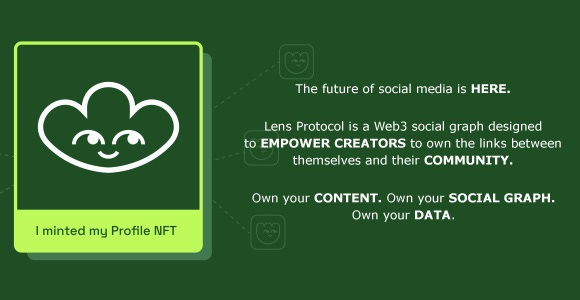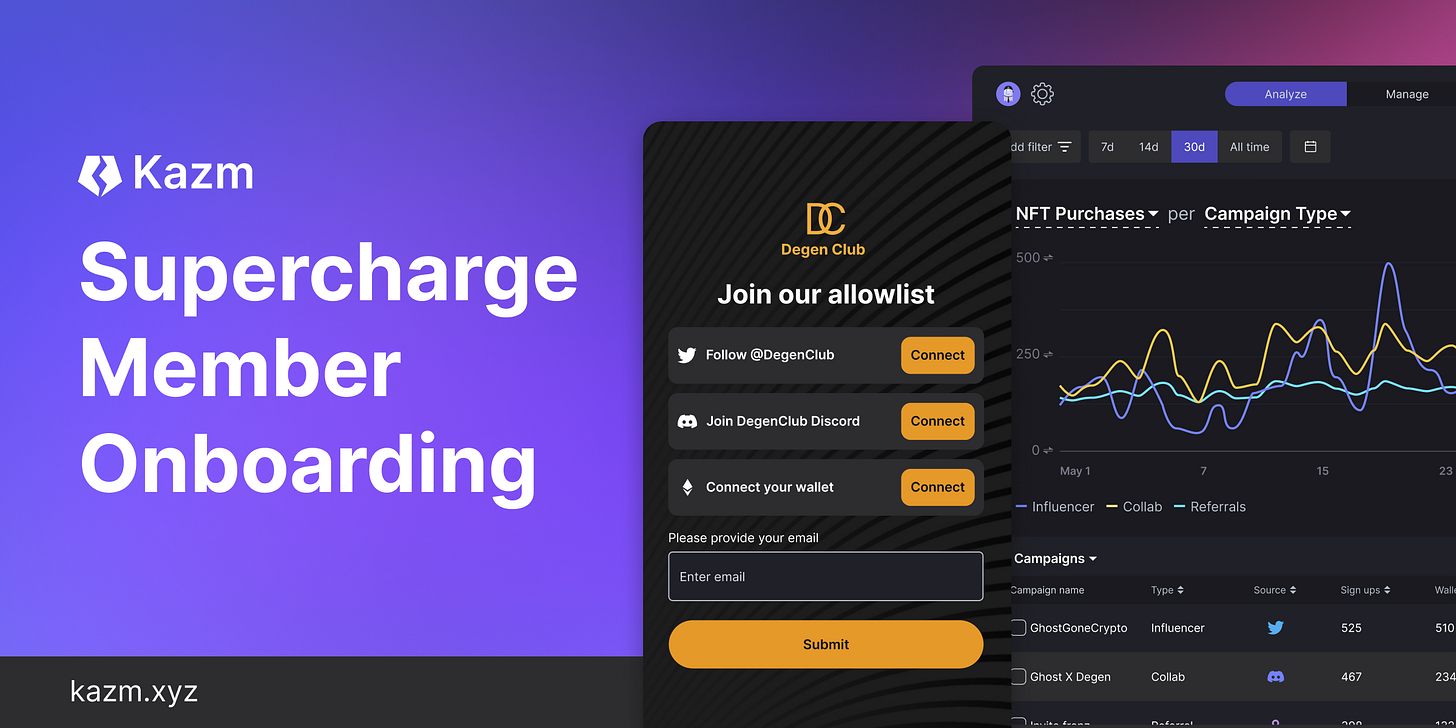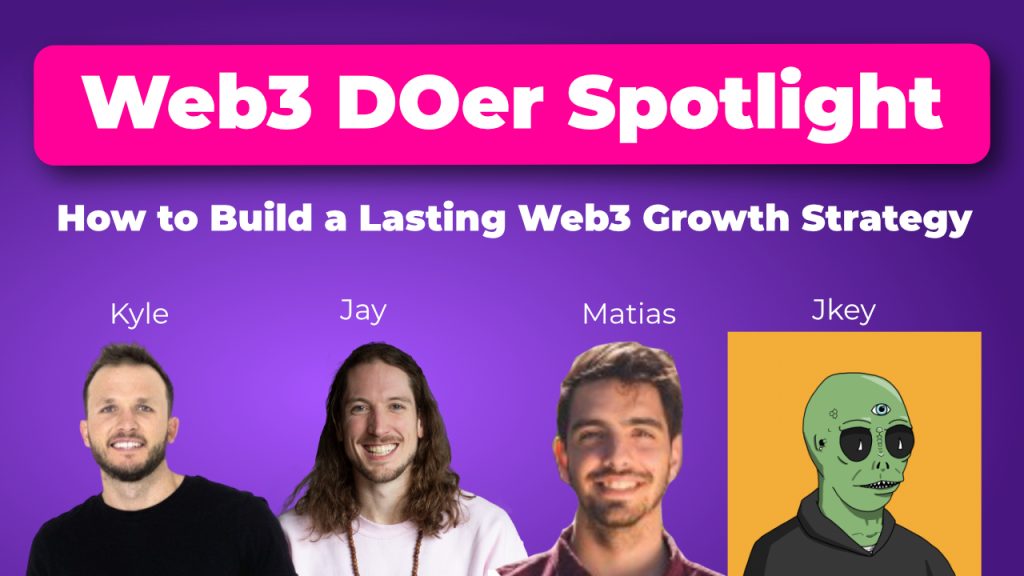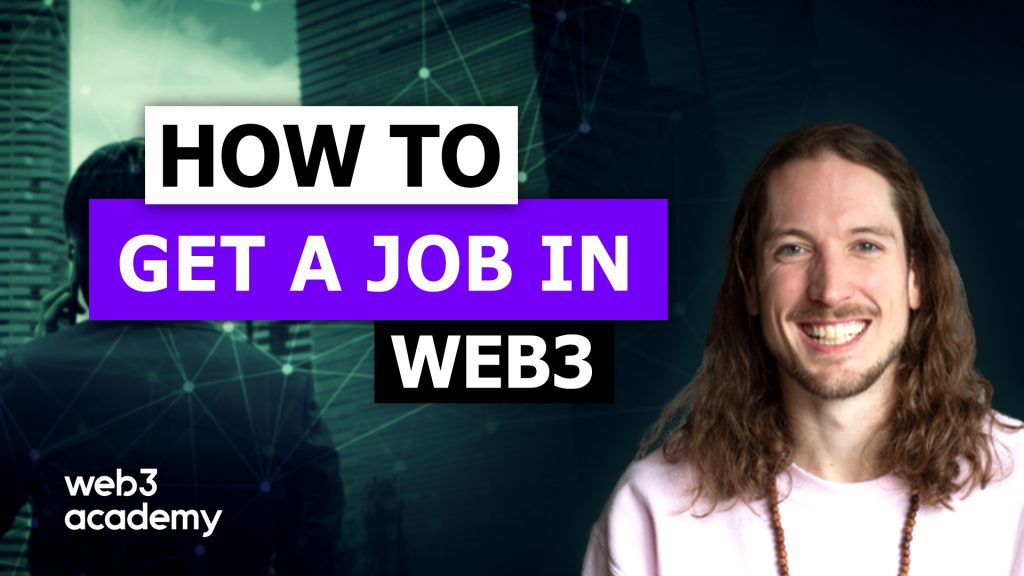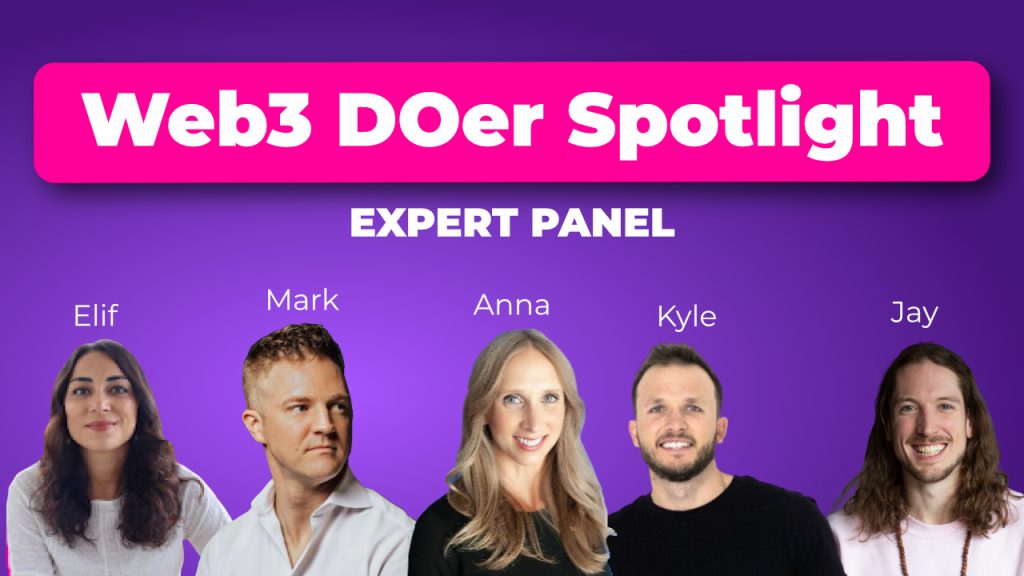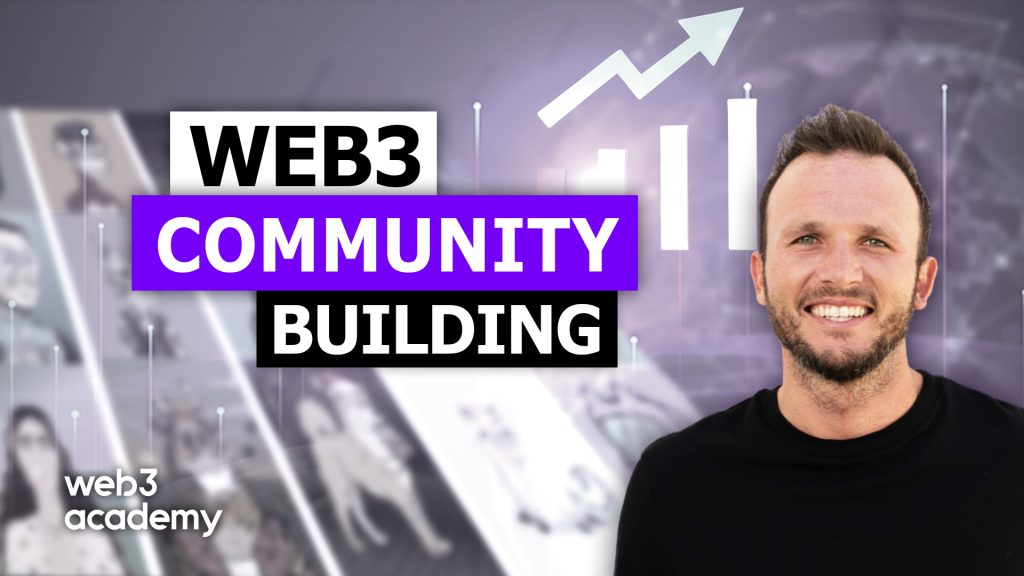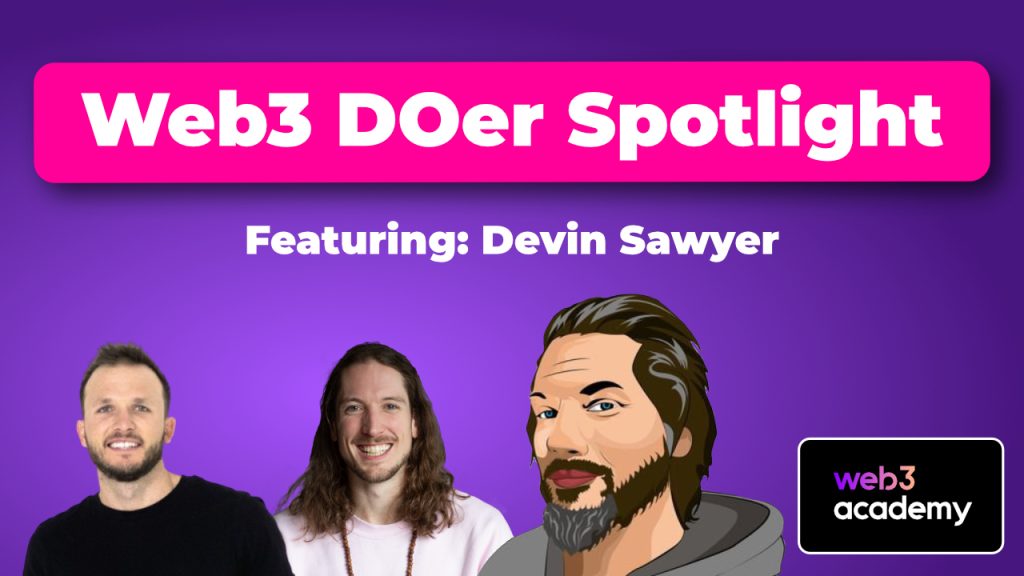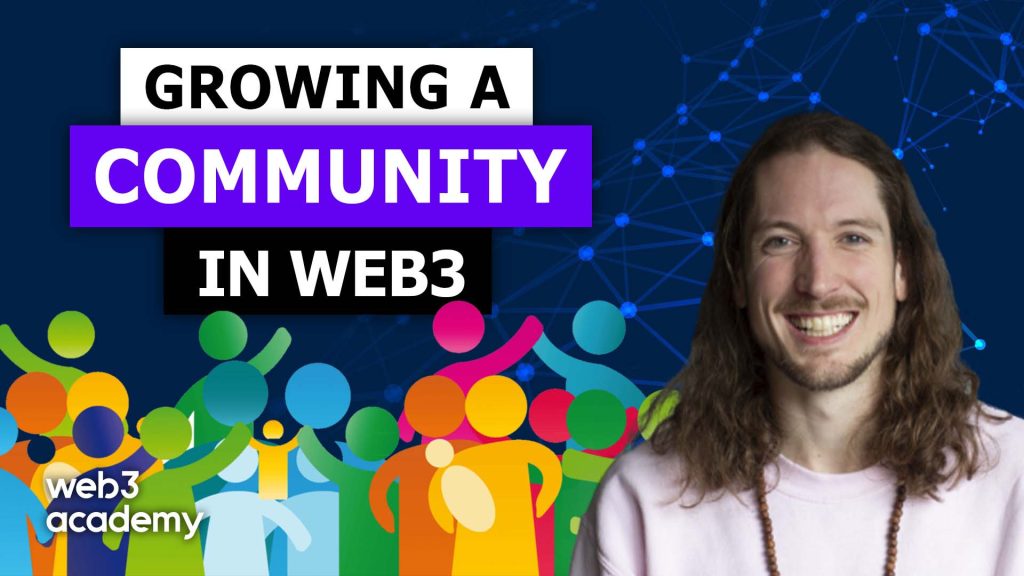
Community Performance Marketing: Taking Web3 Growth to the Next Level
What it is and how you can implement it in your own company
No time to read? Learn all about community performance marketing through your favorite podcast platform 👇
GM DOers!
It’s no secret that the top web3 projects right now all have one thing in common—strong communities.
But how can you develop repeatable, effective community marketing strategies so that you too can win in web3? 🤔
To shed some light on this question we have Thomas Pan, an expert web3 growth marketer and strategist, and the brain behind Web3 with TPan.
In this week’s Deep Dive, he breaks down:
- The current state of community in web3 🧑🏻🤝🧑🏻
- How to think about and prepare your team for community growth marketing 💭
- How community can become a business function 🛣️
- Arguments against community initiatives 😡
Note: We’re looking for another writer to join our ranks and help us create kick-ass content! So if you’ve got a knack for words and a passion for web3, learn more about the role today.
Now, let’s dive in.
👉 Brought to You by Lens: The Future of Social Networking 👀
Community Performance Marketing With TPan
Oh boy, another ‘community is important’ piece 🙄
Yes, AND I think there are some critical pieces missing from the concept of community.
Despite all the attention, fanfare, and LinkedIn posts (mine included) highlighting the importance of building and fostering a community, most haven’t unlocked true flywheel growth, and it shows with the current market.
I don’t have all the answers, but I believe that the strongest businesses will lean into Community Led Growth (CLG).
On top of this, the backdrop of a recession will provide a fertile ground for “Community as a business function” to rise in prominence during the next market cycle of investment, growth, and opportunities.
But Where is Community Now?
Let’s be honest. This is where we’re at.
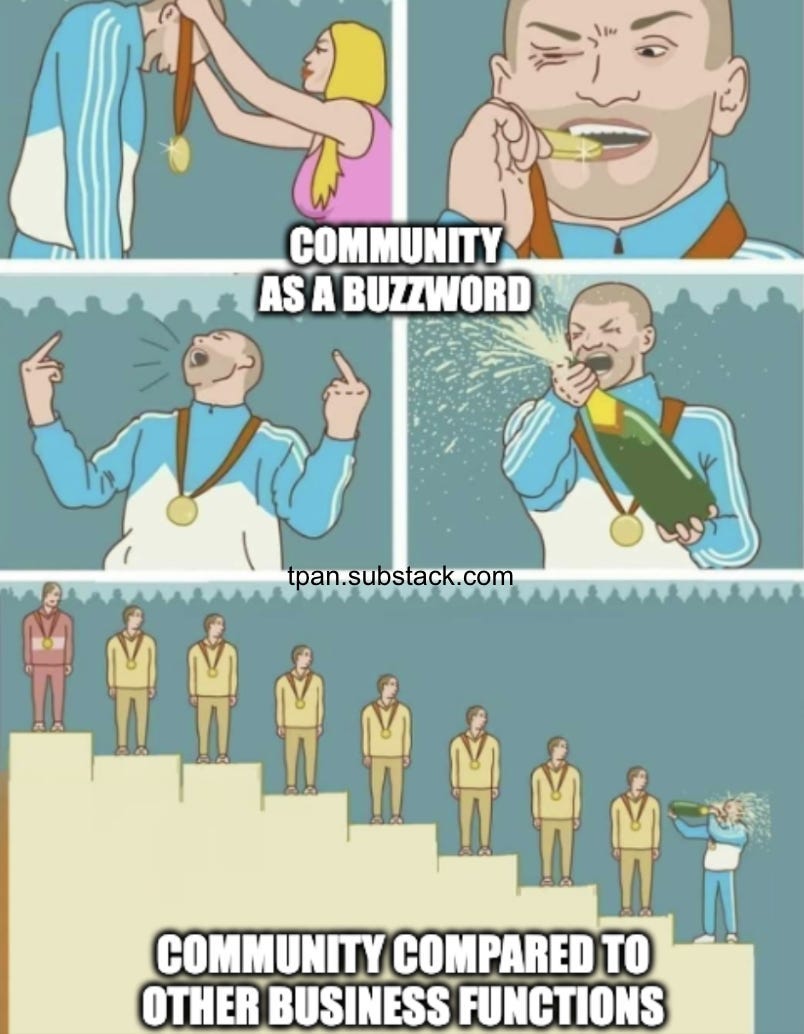
But there are exceptions to this. I’ve heard of some top community talent making $100k+ as experienced Discord mods. I also imagine the community team at Yuga Labs is compensated well and is skilled at what they do. 👩💻
That said, I believe that the vast majority of community roles are:
- Treated as an elevated customer support role and maybe sit within that function.
- Aren’t empowered to make meaningful business decisions.
- Are not provided the resources (skills and budget) to level up and provide more value to the business and community itself.
This is where my predictions about Community come in:
- More growth and performance marketers will shift into community-related roles AND skilled community managers will level up into growth and performance marketing roles. Identifying who is the best fit for these roles in either direction will be key.
- Community functions will start building best-in-class frameworks and playbooks to show impact and demand a budget. If done correctly, the signal will be clear as day and the best organizations will create budgets for this to scale.
- Community will become a business function that will rise in prominence. Community may become a subset of a broader function like Marketing or Growth, or become its own function with full-stack support (creative, eng, product, etc.)
Community Growth + Upskilling Community Roles
How many Community Managers understand the concepts of ROI (Return on Investment), K-factor, LTV (Lifetime Value), CAC (Customer Acquisition Cost), user cohorting, or attribution?
How many are comfortable having conversations with Product Managers, Data Scientists and Analysts, or Performance Marketers?
I believe that number is growing, but it’s not high. Additionally, understanding a concept is different than implementing it in practice. 🤷
How many Growth professionals understand the above concepts? Nearly all, or at least the expectation is to understand them well over time.
As community-building becomes a strategy that all companies and brands employ (at least to a degree), cross-training and upskilling community teams will be instrumental in growing the community. And as a result, the business.
What does growing a community mean for TPan? 🤔
- Focusing beyond the vanity metrics of topline numbers:
- Topline community membership ➡️ Engaged membership
- Engaged membership ➡️ Types of engagement by member
- Types of engaged members ➡️ Understanding user personas and identifying the actions that lead to the highest value members
- Focusing beyond the channels where the community lives:
- The community has a presence on Discord, Twitter, etc. ➡️ Understanding the content that the community engages with
- Understanding the content the community engages with ➡️ Understanding why the community engages with specific content
- Understanding why the community engages with specific content ➡️ Creating content that provides value and results in specific actions
- Redefining what it means to build a community
- Building a community of customers and users ➡️ Building a community of customers that care about each other and are providing value to each other
- Events and activations led by the Community Team for the community ➡️ Partnering internally and externally to create activations that benefit the community while moving the needle for the business in a measurable way
This is where Growth folks can help their Community colleagues better understand how their role and impact can be more effective for the community, themselves, and the overall business.
I imagine if I were to share this with my growth peers I’d get a version of this.
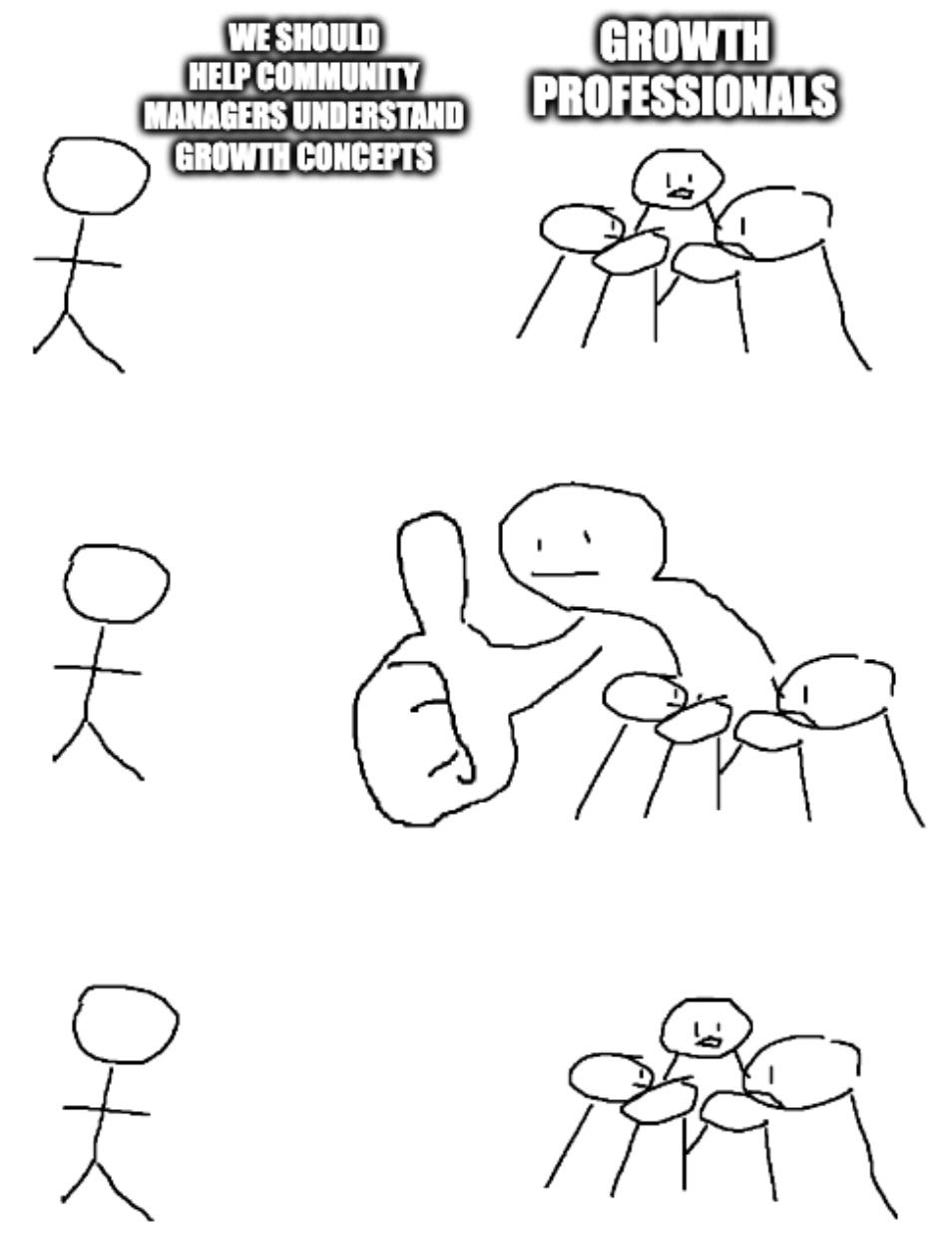
This is where a shift in perspective and alignment of incentives is critical. To find the right individuals that are willing to collaborate, humility and openness are needed in a bi-directional manner.
Who are the people in Growth functions that are willing to invest, partner, and educate their Community colleagues to supercharge aligned goals? Are goals even aligned? Who are the Growth pros that enjoy interacting with the community?
Community isn’t just about numbers either. There are softer, more qualitative aspects to this, like spending time with the community and saying hi.
Can you measure the direct impact of every hand the President shakes? No. But that shouldn’t stop you from shaking those hands and kissing those babies.
On the other hand, who are the people in Community functions that are hungry to learn how to apply Growth concepts and frameworks to supercharge the impact of their efforts for the community?
It’s important to note that this isn’t a cross-functional relationship that is a weekly 1:1 to check in and provide ideas.
There needs to be an investment on both sides to truly understand each other. Until then, Community as a Growth strategy will be limited.
As an additional incentive for Growth professionals to better understand community is that the ‘organic’ channel has generally been elusive. What’s an organic user or organic channel?
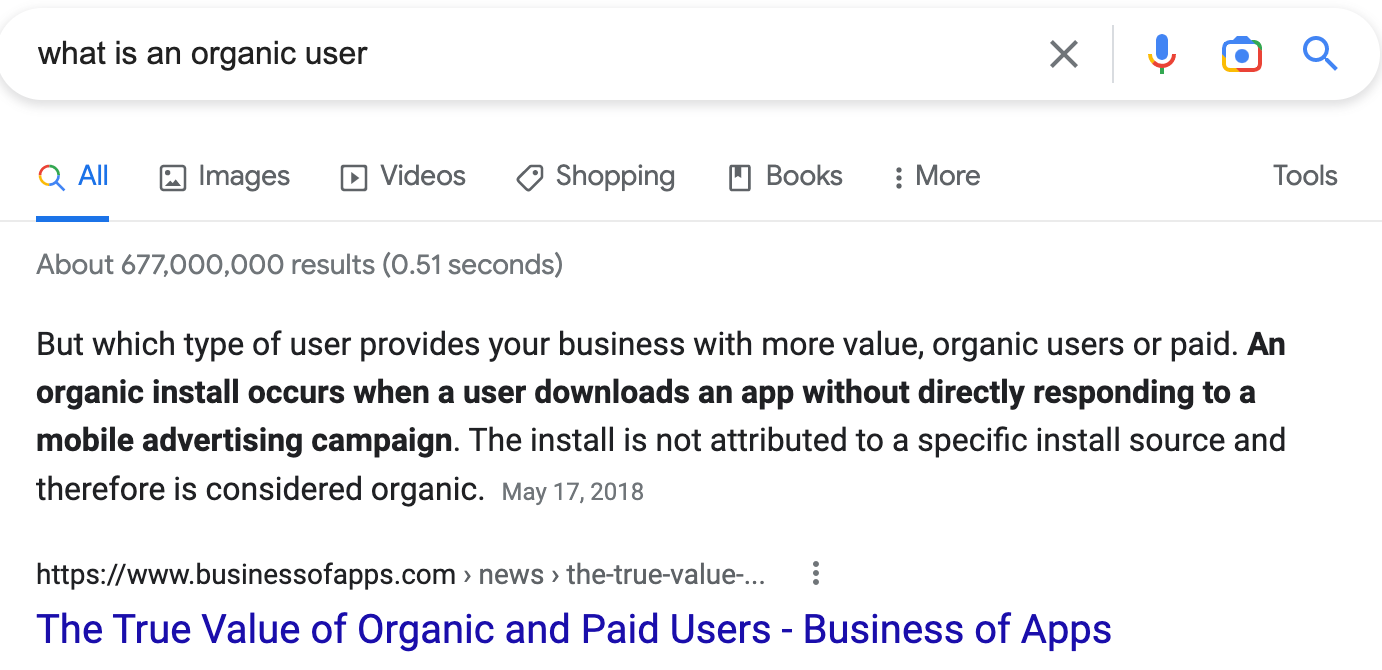
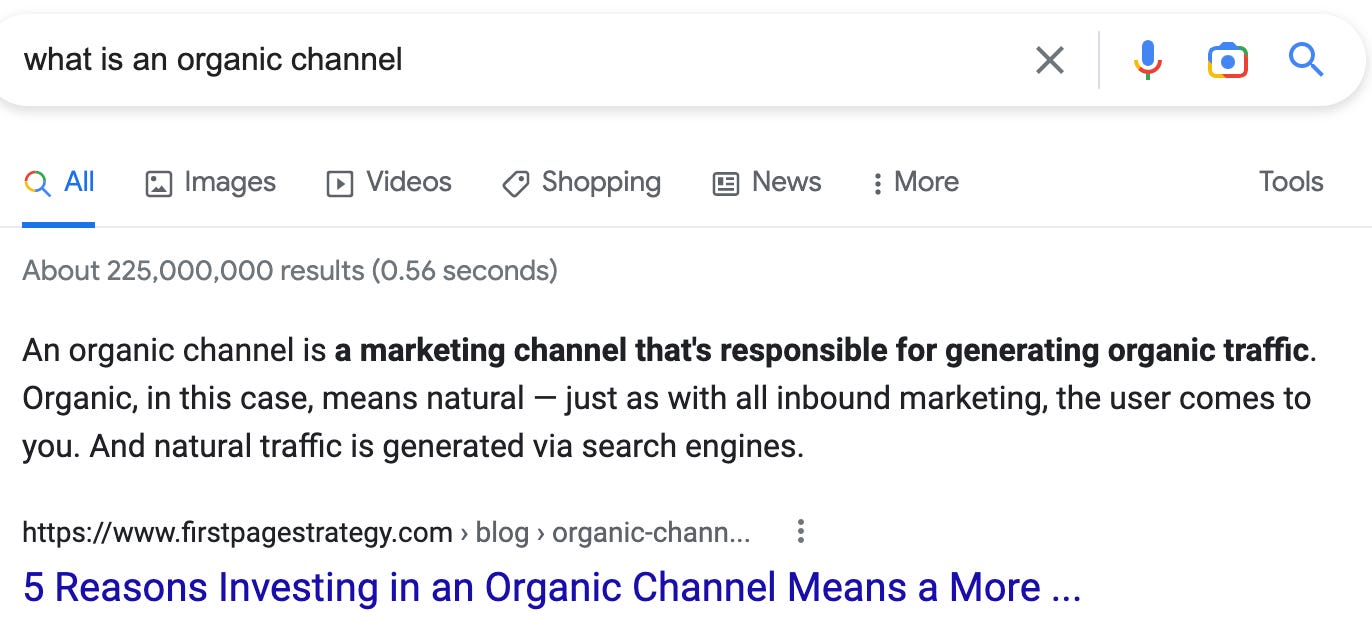
As Community rises in prominence, I believe these definitions will become outdated. Organic traffic will never be fully measurable, but I believe Community can play a much larger role in helping us understand the catch-all definition.
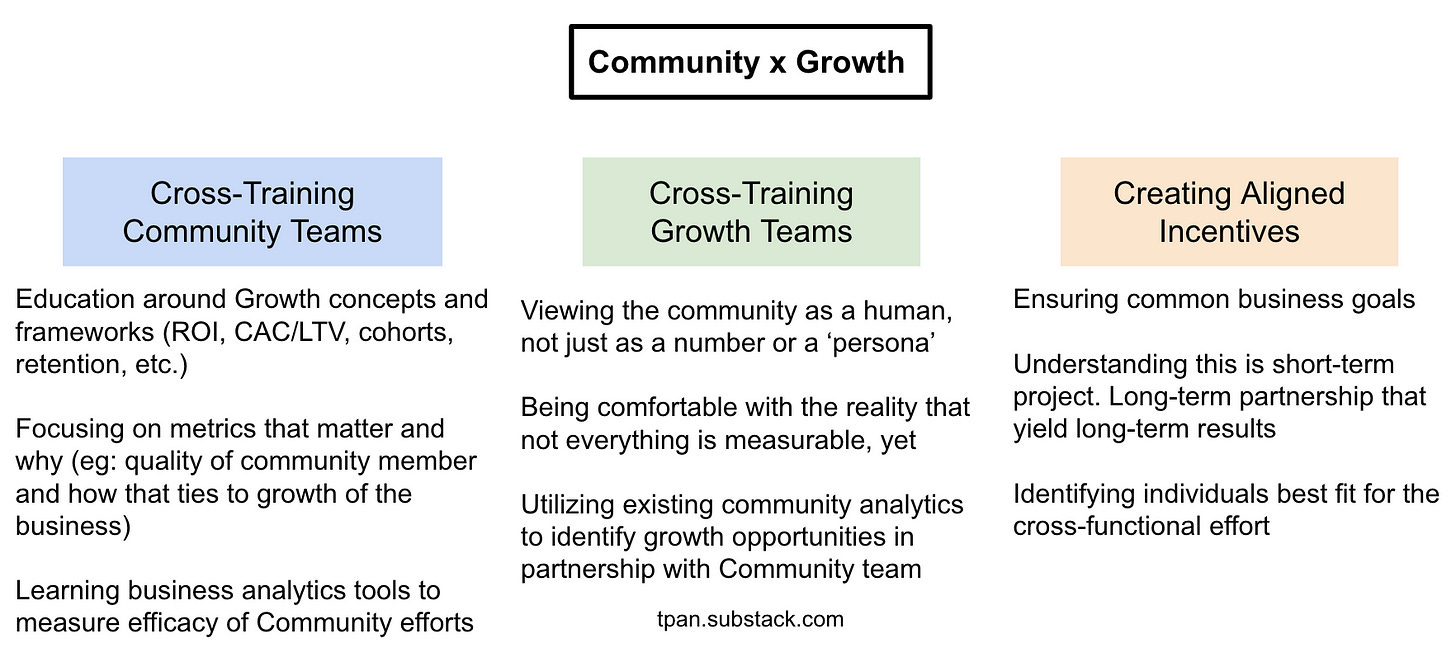
So with that, what can Community Growth as a practice look like?
🤝 Together with Kazm: The All-In-One Tool for Building a Thriving Web3 Community
Are you building a community in web3? Then you need Kazm, the tool we use to onboard our members and launch data-driven campaigns that optimize growth and engagement.
Best-in-Class Community Growth Through Measurement and Playbooks
Let’s take a couple of hypothetical examples to see how Community 🤝 Growth.
Ford
WTF, Ford?
Yes, Ford the car company. I’ve been seeing a lot of car commercials as the NBA and NFL seasons have resumed, so why not. 😂
How much does Ford spend a year on advertising?
But what if…
As a test, Ford took 1% of that budget ($31 million) to run a pilot program to kickstart community building. Screw that, even 0.1% of the marketing budget, which would be $3.1 million. That’d be plenty.
What could this community pilot look like? 💭
Choose five dealerships per global region and test different types of community-building initiatives, such as:
Event-driven Community Building (virality):
- Every month, one random prospective Ford buyer gets their vehicle for free right before they sign on the dotted line. No questions asked.
- Every other week, one random prospective Ford buyer gets their vehicle at the base model price with all add-ons for free right before they sign on the dotted line. No questions asked.
- Every week, one random prospective Ford buyer gets free service for X years right before they sign on the dotted line. No questions asked.
Education-driven Community Building (value):
- Every month, host an education day around a car-related theme. How to change your engine oil, how to determine if you’re paying the right price for a used car, etc. Free food (GOOD food) and bring your kids if they love cars.
- Host ‘Ford Office Hours’. If you have questions about your car and want an expert opinion, come right in. You can take this further by inviting owners of other brands as well. Hire part-time specialists if needed.
- Highlight and reward community members for service to their local community. Create a communal space for community events.
Long-term Community Building (virality + value):
- Incorporate both of the above strategies.
How would the success of this effort be measured?
- Incremental sales in the short and long term.
- Incremental sales in surrounding dealerships (halo effect).
- Media exposure and social listening, particularly with the viral community-building strategy.
- The amount of new customer info gained, such as emails collected, referrals, and if they don’t drive a Ford, you can gather their info via the education community building strategy.
Assuming this works, build out a playbook to scale this across regions and globally. Then hire full-time Community managers that are responsible for growing a Ford customer community. But make sure the playbooks are complementary to cultural nuances and what the community cares about. ✅
If success continues, a portion of the $3.1 billion marketing budget shifts from paid marketing to community marketing.
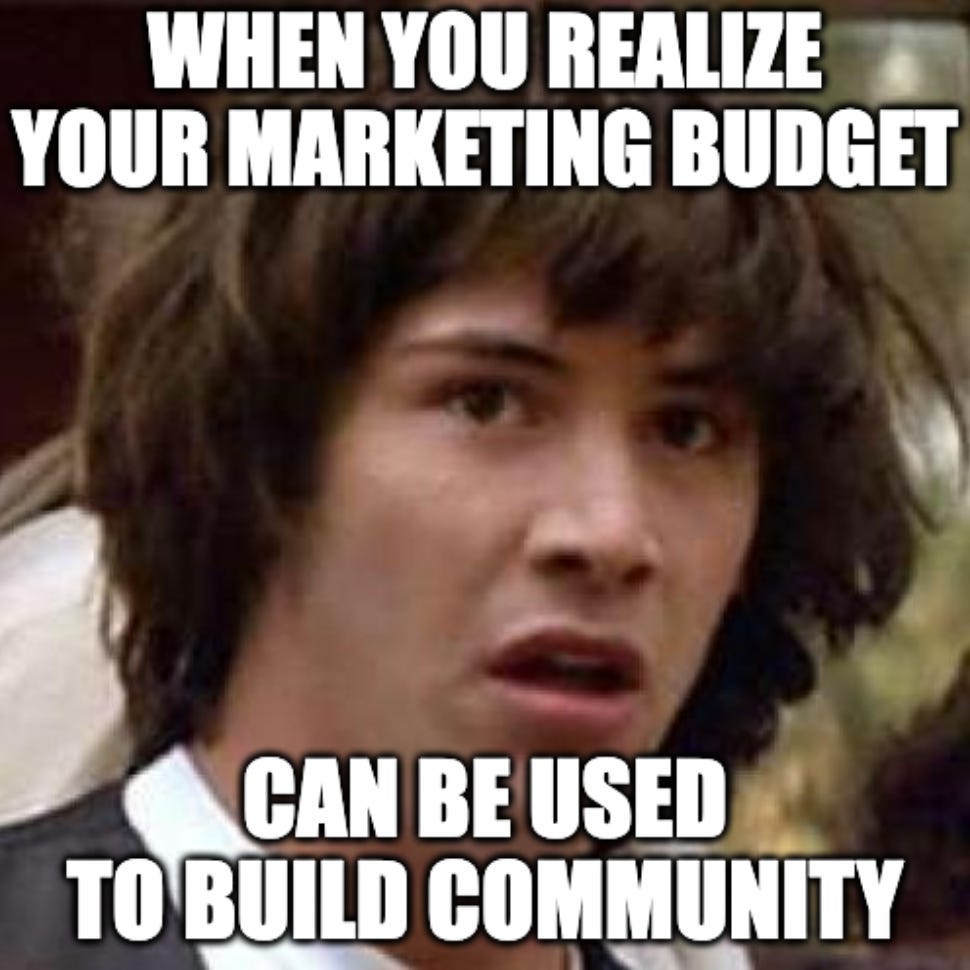
Doodle Putt
Doodles are holding an event at Art Basel next month: Doodle Putt.
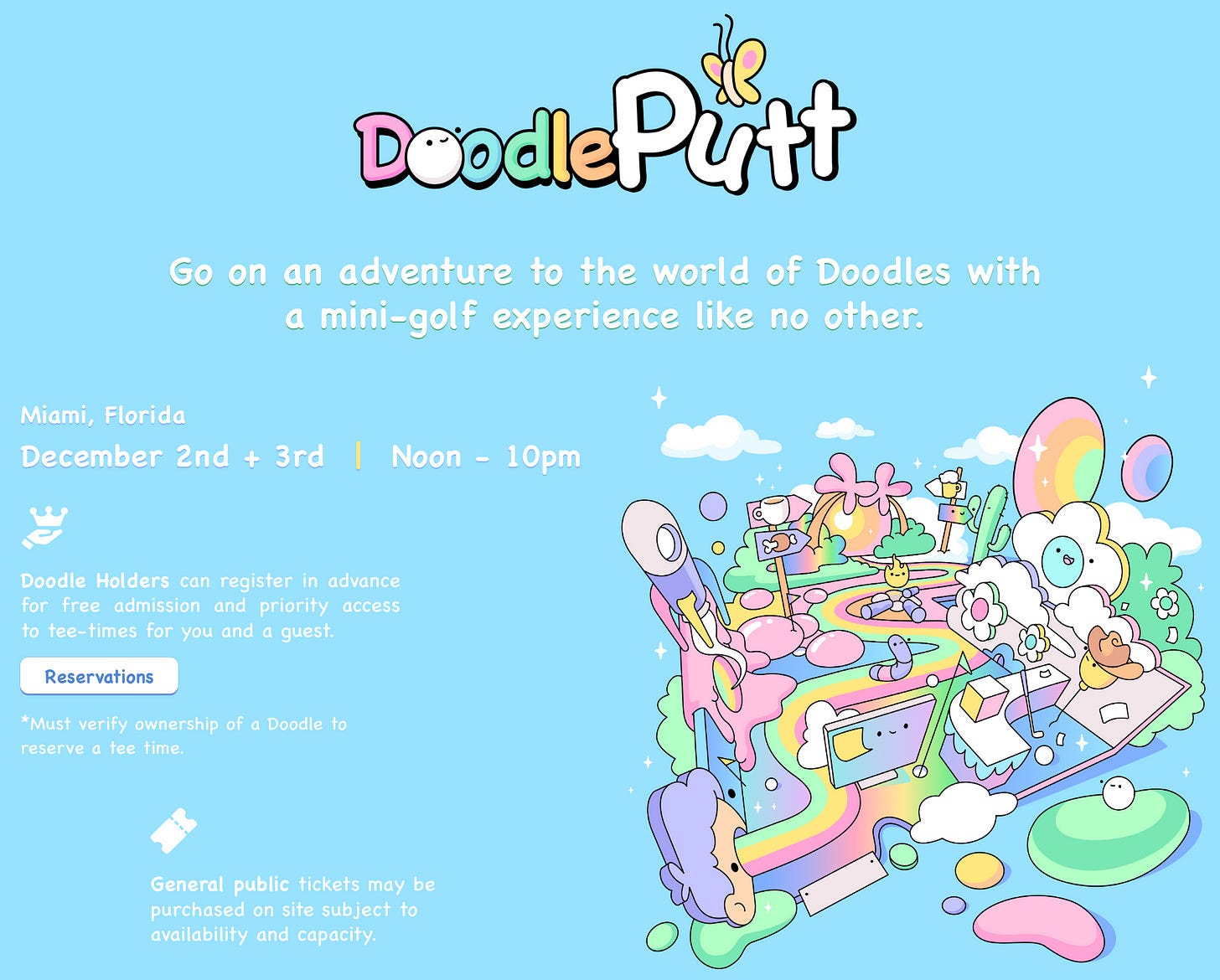
This 9-hole mini-golf course is absolutely on-brand for Doodles. Knowing them and their history of activations, this is probably going to be a banger.
In this actual example, how might Community 🤝 Growth?
- Community Impact:
- How many holders attend the event?
- How does this event impact social media and Discord community activity? How does this event impact the quality of the community activity?
- What is the feedback on the event? Think in-person feedback, feedback forms, and on social/Discord.
- Business Impact:
- How much Doodles merch was sold at the event and/or online? Are there attributable moments causing a spike in sales?
- Was the AOV (Average Order Value) for activations attendees greater than online purchases?
- Do people who attended the activation purchase multiple times?
- How does the event impact secondary sales on NFT marketplaces like Opensea?
- Brand Impact:
- Are news outlets covering the event? What is the sentiment? What is the reach?
- How many non-holders participated in the activation? What brought them here?
Doodles have a couple of notches under the belt with these types of activations and they’ve built a community since inception.
So I imagine the team has a more focused framework with how they measure success and how they can use these insights to continue fostering a healthy community while growing the business.
But if they don’t, this is where they can start. 🤷🏻♂️
Note: If you want to understand how Reddit is using a community-first approach to win in web3, make sure to read: Is Reddit Writing the Playbook for Bringing Web3 to the Masses?
Tools to Help with Automation and Measurement
As Web3 is showing early signs of maturity, Community Management tools have arrived on the scene:
- Blaze: Campaign management, user segmentation, wallet insights.
- Dots: Automation flows and community insights.
- Landing Party: Support bots, support ticketing, and help centers.
…and plenty more.
Tools like these help with creating the community playbook as well as provide a common ground for Community 🤝 Growth outlined earlier.
Community as a Business Function
As companies and brands scale, Community can turn into a business function of its own.
Here’s what this might look like from 0 – 100:
Phase 1: Minimum Viable Community (MVC)
- Community lead with support from various functions
- Focus on digital channels to build community
- Understand the ‘1,000 true fans’ and what they engage with and why
- Test and learn
Phase 2: Scaling community
- Building out community team
- Expand digital footprint and consider physical footprint where appropriate
- Cross-functional partnerships to measure impact
- Build frameworks and playbooks
Phase 3: Community as a business function
- Scale community team: Community managers, community relations, community ambassadors
- Omnipresence across channels and ecosystem
- Establish an independent budget for community building and scaling efforts
- Build cross-functional playbooks to create a 1+1 = 3 impact
I’m not strictly defining what small, medium, and large looks like intentionally.
A large company still needs to start small and then scale up. Also, certain pieces may come in earlier phases. Some companies may be able to create a budget at an earlier point than others.
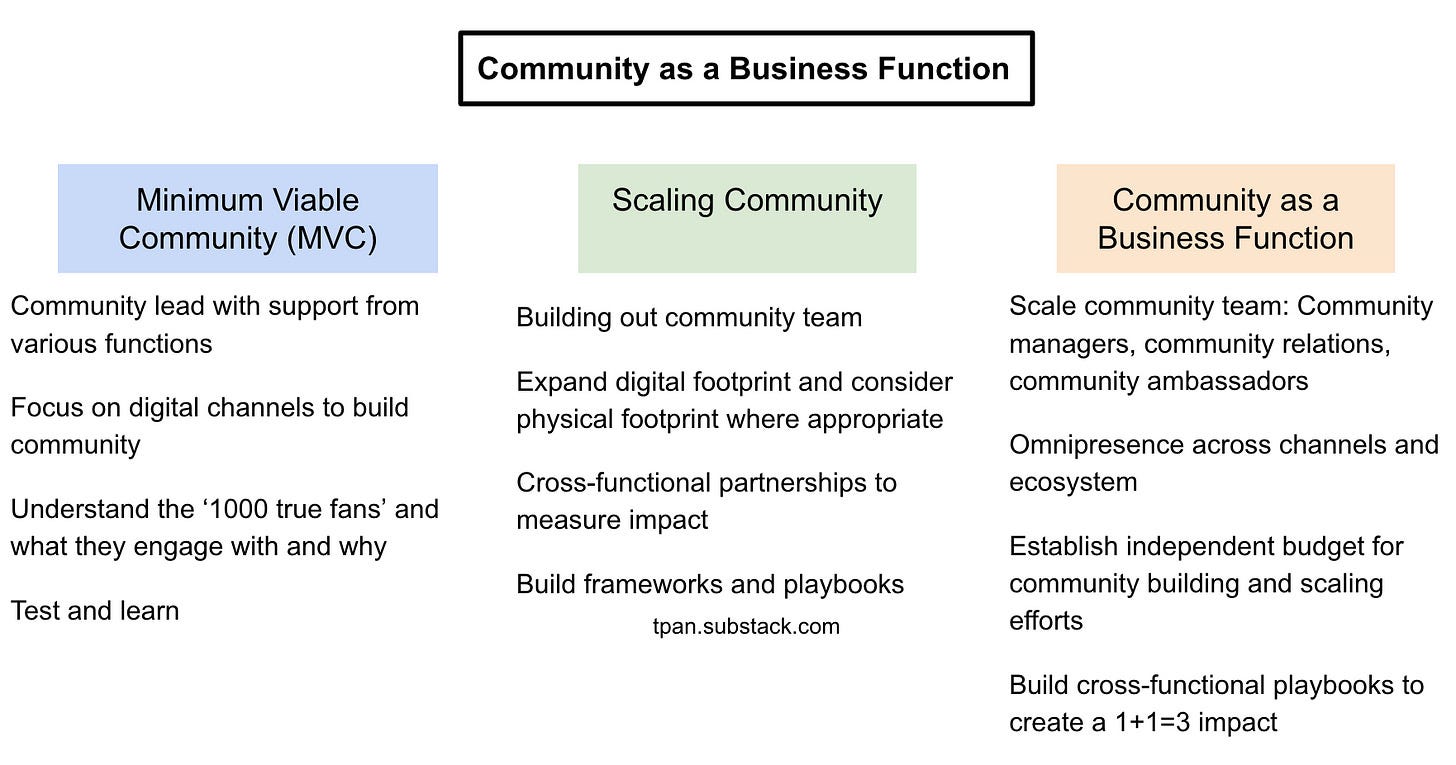
Another source of inspiration is B2B companies and how they build community with existing and prospective clients. It’s arguably easier to do than B2C because there is a smaller community base.
Bessemer Venture Partners recently wrote a piece about community-led growth, featuring several portfolio companies and their strategies.
You don’t have to start with 0 when you’re thinking about how to create a community. There are plenty of examples out there and they might not be called a ‘community’ in the traditional sense.
A great example of this is the role of Developer Relations teams.
How do DevRel teams foster strong communities? How do they measure success? How do they balance a digital and physical presence?
Now, what happens when you replace ‘Developer’ with ‘Community’? 🤔

SOCIALS
Meme of the Week

Arguments Against Community Growth
If I’m making a case for something, it’s only fair to think through arguments against it.
Community as a strategy isn’t right for everyone
I generally disagree with this. However, if I were to peel the layers of the statement there are two questions that lead to this argument:
- When is the right time to build community?
- What kind of community should be built?
If you’re an Amazon drop shipper, you don’t need to build a community because amazon does that for you. All you have to do is focus on getting more products and optimizing them to show up as the first result.
However, once you get to a certain scale, you can incorporate community building by creating a Youtube channel that reviews various Amazon products, including your own. 😉
Community doesn’t drive business results
It’s fairly clear that communities drive business impact. The missing piece is having the resources and knowledge for Community professionals to show that, which goes back to my first prediction and point.
In fact, I believe strong communities combined with creative marketing strategies will create outsized results—just look at any top-tier NFT brand.

Getting too close to the community is a business risk
This a valid point. But empowering and engaging your community is not the same as giving the community the authority to make business decisions. The key to this is to draw healthy boundaries between your community and company.
Community ≠ Employee.
This is why starting small and scaling up—especially for larger companies—is important.
Understanding the motivations and personas of your community are key to success. If the goal is just financial gain, things can get ugly quickly so you must know what motivations you’re dealing with.
Community isn’t proven for ____________
This is another fair point, especially when communities are web3-enabled with an ownership component. We’re still in the early innings of that.
Similar to how blockchain games have been largely unsuccessful so far, every major gaming studio is attempting to be the first to figure it out. After all, the reward for doing so will be substantial.
It’s also easier to lead with authenticity. Back to blockchain gaming, the game needs to be fun first. If it isn’t fun, no one will care about the NFTs in the game or how much you might be able to earn.
Why play a boring game when you can just ape into DeFi protocols?
What about if a company has a strong Community management team, but the CEO begrudgingly engages with the Discord server or Twitter Spaces? The situation is the same.
In a world where everything is increasingly turning into an advertisement and people question if something is ‘real’, authenticity wins. Communities thrive off it.
I want to reemphasize that Community Growth is an evolving discipline. I believe there will be more and better frameworks and examples than what I’ve provided. Maybe Ford has already tested this local community concept and I’m not aware!
Regardless, I hope they provide a spark or new ideas of how to think about building community.
See you next time, frens! 💪
ABOUT THE AUTHOR
Thomas Pan
Web3 growth marketer and strategist, and the brain behind Web3 with TPan.
Find him: Twitter

FOR THE DOERS
Take Action & Level Up
LEARN
Take our FREE Web3 Rabbit Hole Course to get up-to-speed on the foundational components of Web3 so you can confidently build, work, or use the fastest growing technology in history.
JOIN
Get the #1 web3 resource for learning which businesses, business models, and tactics are winning in the space: Web3 Academy PRO.
READ
Community is built through shared experiences and values. One way to combine these is through well-thought-out membership programs. Learn: How to Create a Membership Program with Unlock Protocol.




